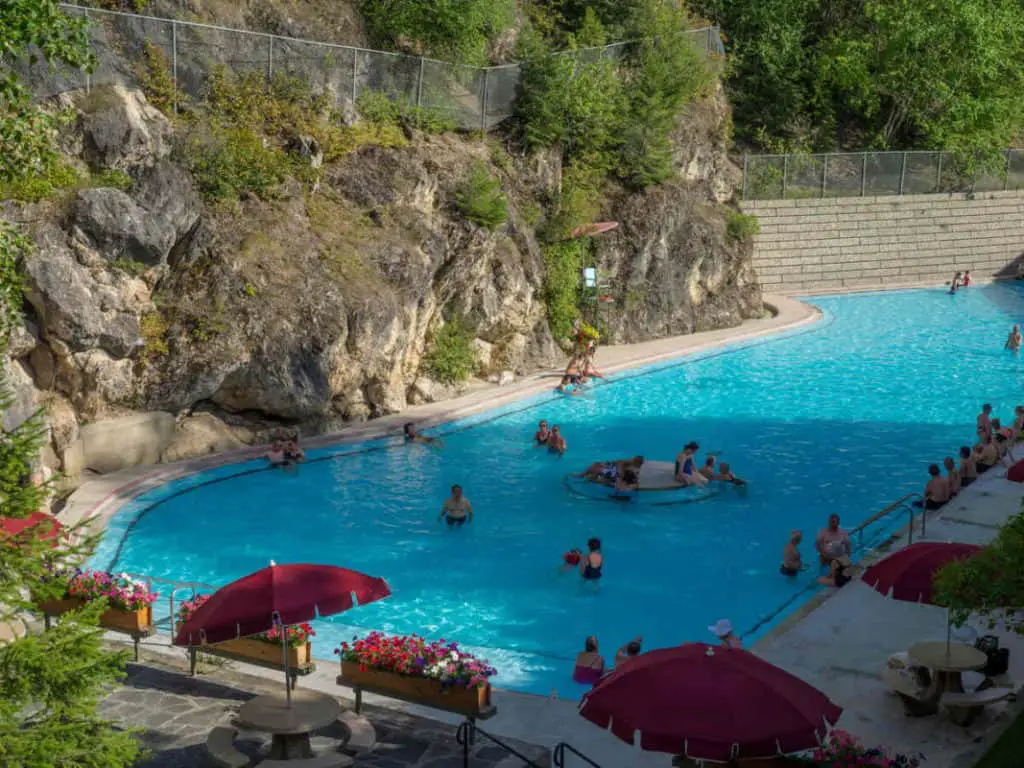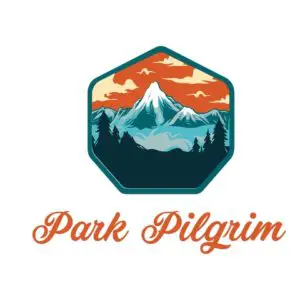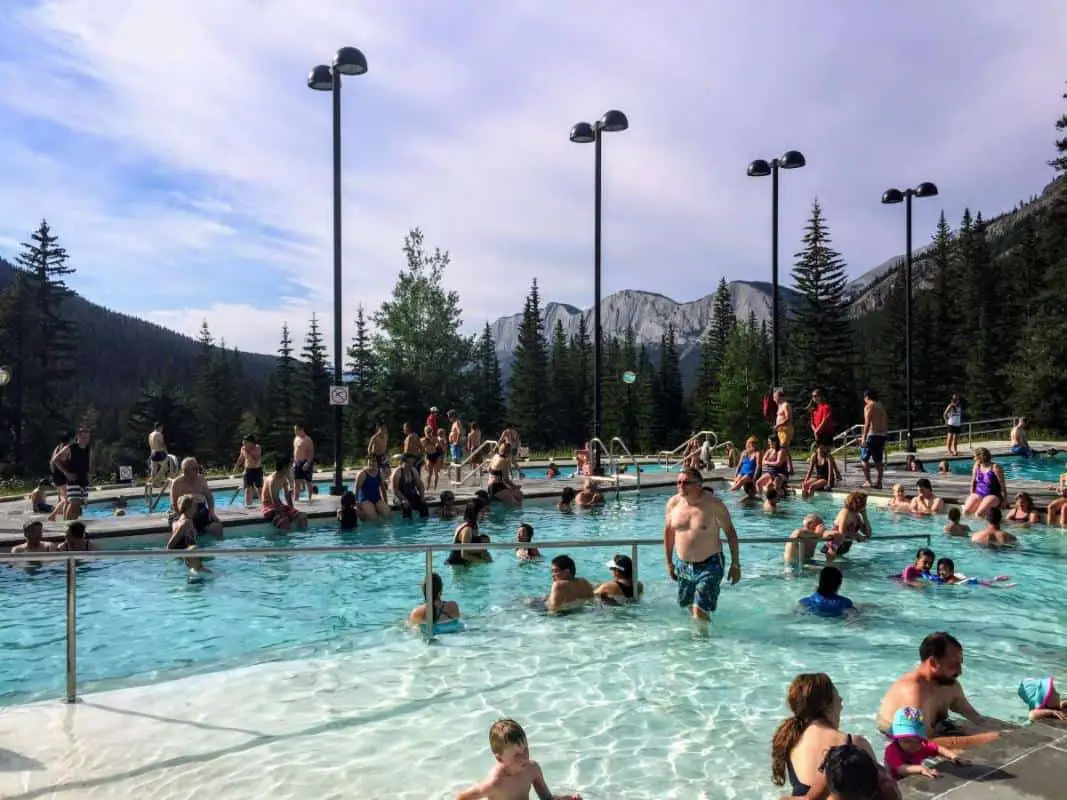Relaxing in a nice warm pool and taking care of your body and skin simultaneously. You can do it in a hot spring. Alberta has three and one is conveniently located in the town of Banff. What’s involved with these springs and what are the pros and cons? You’ll read it in this post.
A visit to a hot spring is first and foremost a pleasant and relaxing way of spending your time. Imagine yourself soaking in the warm mineral water looking out over the Rocky Mountains. There are worse ways of spending your time, right?
The cool thing about hot springs is that they contain quite a few minerals, which are known to be beneficial to your body. So you might come out as a whole different person… Okay, maybe not, but these hot springs are definitely delightful and absolutely worth checking out.
What Natural Hot Springs Are There in the Banff Area?
In the Banff area, there are four natural hot springs that you can visit without having to spend all day just to be able to relax in natural hot springs.
Banff Hot Springs
The Banff Upper Hot Springs or Sulphur Mountain Hot Springs are the origin of Banff National Park and the reason for its creation. An outdoor pool is located on the flanks of Sulphur Mountain. It gets its hot mineral water from the Sulphur Mountain Thrust Fault, a crack in the mountain.
The Banff Hot Springs temperature is between 37 and 40 degrees Celsius (98 and 104 degrees Fahrenheit). It is located at an elevation of 1585 meters, making it Canada’s highest hot spring. From the pool you have a breathtaking view of Rundle Mountain and the Bow River below.
Please note: reservations are not possible.
Minerals in Banff Hot Springs
- Bicarbonate: 134 mg/l
- Calcium: 205 mg/l
- Magnesium: 42 mg/l
- Sodium: 6.6 mg/l
- Sulfate: 572 mg/l
Getting there
The Banff Upper Hot Springs are located on the flanks of Sulphur Mountain, south of the town of Banff. From Banff Avenue drive up on Mountain Avenue. You’ll end up on the Banff Upper Hot Springs and the Banff Gondola parking lot.
Though limited, on-site parking is possible as the Banff Hot Springs share their parking facilities with the Banff Gondola. RVs must park in the back lot (more space to maneuver). You can also take a bus. ROAM bus route 1 takes you there.
Banff Upper Hot Springs
Address: 1 Mountain Avenue
Phone: +1 800 – 767 1611
Website: hotsprings.ca
E-mail: through form on the website
ADMISSION
Adult (18-64): CAD 9.25
Youth (3-17): CAD 8
Child (under 3): Free
Senior (65+): CAD 8
Family*: CAD 29
Extra Youth: CAD 5
* The family rate applies to each of the following combinations:
- Two adults and two youths
- One adult and three youths
- Two seniors and two youths
- One senior, one adult and two youth
- Four siblings
Group Rates (10 or more people pay in one transaction and arrive together)
Adult (18-64): CAD 8.25
Youth (3-17): CAD 7
Senior (65+): CAD 7
Radium Hot Springs

After the Banff Hot Springs, Radium Hot Springs is probably the most well-known one in Alberta and British Columbia. You’ll find this hot spring just across the border in BC, three kilometers northeast of the village of Radium Hot Springs.
Situated in the East Kootenay region, the Radium Hotsprings provides a relaxing and vitalizing bathing experience in the Rocky Mountains without the clamor and hubbub the town of Banff is known for.
The pool is kept at 37-40 °C (98 and 104 degrees F). It is significantly bigger than the one in the town of Banff. In fact, it’s the biggest hot spring in the Rockies (including the US). Besides the outdoor hot pool itself, there’s also a cool pool of 25 meters (27.34 yards), a restaurant and the place also offers relaxing massages.
Please note: It’s not possible to make reservations (but also not necessary).
Minerals found in Radium Hot Springs
- Bicarbonate 100.8 mg/l
- Calcium 135 mg/l
- Magnesium 31.6 mg/l
- Silica 31.8 mg/l
- Sulfate 302 mg/l
Is Radium Hot Springs Radioactive?
This might scare you, but the Radium Hot Springs are actually radioactive. Here’s why:
The springs were named after radon, a decay product of the radioactive element radium found in the water. Visitors don’t need to fear health risks. The radiation dosage from bathing in the pools is negligible.
Getting there
Getting there from Banff or Lake Louise is easy. Just follow the Banff-Windermere Highway (Highway 93). At the Castle Mountain Junction, take the exit on the Trans-Canada Highway, south of Lake Louise. It’ll lead you straight to the springs.
On-site parking is possible. You can also park your RV here.
Radium Hot Springs
Address: 5420 BC-93, Radium Hot Springs
Phone: +1 800 – 767 1611
Website: hotsprings.ca
E-mail: through form on the website
ADMISSION
Single entry
Adult (18-64): CAD 8
Youth (3-17): CAD 6.75
Child (Under 3): Free
Senior (65+): CAD 7
Family*: CAD 24.50
Extra Youth: CAD 4.50
Day passes
Adult (18-64): CAD 12.75
Youth (3-17): CAD 11.25
Senior (65+): CAD 11.75
Family*: CAD 39.50
Extra Youth: CAD 8
Group rate (10 or more people must arrive together and pay in one transaction)
Adult (18-64): CAD 7
Youth (3-17): CAD 6
Senior (65+): CAD 6.25
*The family rate applies to the following combinations:
- Two adults and two youths
- One adult and three youths
- Two seniors and two youths
- One senior, one adult and two youths
- Four youth (siblings)
Youth under the age of 7 must be accompanied by someone 12 or older.
Miette Hot Springs
These hot springs are located in Jasper National Park. Like the Banff Upper Hot Springs and the Radium Hot Springs, it’s set in the beautiful scenery of the Rockies and, more particularly, the Fiddle River Valley. The facility has four pools, of which two are hot pools. Furthermore, there’s an excellent café to still your hunger. Miette Hot Springs typically operates seasonally from May until mid-October.
Like the previous two hot springs, the Miette Hot Springs pool temperature is kept between 37 and 40°C (98 and 104 degrees F). They are actually known as the hottest hot springs in the Canadian Rockies. The water you’re soaking in is cooled because it flows from the mountain at 54°C (129°F).
The Miette Hot Springs are situated about 61 kilometers (38 mi) from the town of Jasper. The facility’s operation depends on the availability of lifeguards. There’s no cell phone reception in this area and because the first health center is a one-hour drive away, the presence of qualified lifeguards is essential.
Minerals found in Miette Hot Springs
- Bicarbonate 124 mg/l
- Calcium 307 mg/l
- Magnesium 56 mg/l
- Sodium 10.5 mg/l
- Sulfate 1130 mg/l
Getting there
To reach the Miette Hot Springs, you need to take the exit on the Yellowhead Highway (Highway 16) onto Range Road 275 A (Miette Road). This exit is located at the Pocahontas Bungalow road junction. You can only get there by car or RV. There’s no public transport available to take you there.
On-site parking is available. You can park your vehicle immediately behind the Miette Hot Springs building.
Miette Hot Springs
Address: 117.7698 °W 53.1303 °N
Phone: +1 800 – 767 1611
Website: hotsprings.ca
E-mail: though form on website
ADMISSION
Single entry
Adult (18-64): CAD 7.75
Youth (3-17): CAD 6.75
Child (Under 3): Free
Senior (65+): CAD 6.75
Family*: CAD 24.75
Extra Youth: CAD 5.00
Group rate (10 or more people must arrive together and pay in one transaction):
Adult (18-64): CAD 7
Youth (3-17): CAD 7
Senior (65+): CAD 6
*The family rate applies to the following combinations:
- Two adults and two youths
- One adult and three youths
- Two seniors and two youths
- One senior, one adult and two youths
- Four youths (siblings)
Youth under the age of 7 must be accompanied by someone 12 or older.
Mist Mountain Hot Springs
While the hot springs mentioned above have manmade pools, the Mist Mountain Hot Springs is hundred percent natural. Situated in the Kananaskis area – south of Banff National Park – on the east side of Highway 40, these hot springs are a natural gem.
Though you need to put effort to get there because only a hike up the mountains will get you there. The hike is 6.5 km (4.03 mi) long out and back, covering an elevation gain of about 600 meters (1968 ft). It will take you about two hours to get to the hot springs.
The trailhead is 200 meters (219 yards) west of the parking area (wide shoulder pull-off). A connector takes you to the trailhead (which is not indicated by a sign), straight from the parking lot. Make sure you keep following the right trail because the Mist Mountain Trail partially follows the same route as the Mist Mountain Hot Springs Trail but ultimately leads you somewhere totally different.
Make sure you wear a bathing suit under your clothes because there will likely be other people near the spring. Unless you don’t mind undressing in the presence of strangers… Up to you. Furthermore, don’t expect this spring to be as warm as the ones mentioned above, but do expect to wait in line as it’s a very popular spot. Still, it’s lovely to plunge in the waters at this mystical location in the wilderness.
Please note: the road is closed from 1 December until 14 June.
Other Hot Springs:
1. Lussier Hot Springs. Like the Mist Mountain Hot Springs, these hot springs are not developed. They’re situated near Cranbrook in British Columbia, inside Whiteswan Lake Provincial Park. The springs’ waters are pretty hot. The water in the hottest pool can reach a temperature of 43°C (108°F).
Lussier Hot Springs
Address: Cranbrook, BC V1C 7E2
Phone: +1 250 – 422 3003
Website: lussierhotsprings.ca
E-mail: –
2. Fairmont Hot Springs. These hot springs in the resort community of the same name in BC are close to the border with Alberta, 37 km (23 mi) south of Radium Hot Springs. A soaking pool and a swimming pool draw their water from the local hot springs. Close to the pools, you’ll find a strip mall, gift shop, and restaurants. Also interesting: there’s a warm waterfall behind the resort. Definitely worth checking out.
Fairmont Hot Springs
Address: 5225 Fairmont Resort Road
Phone: +1 250 – 345 6070
Website: fairmonthotsprings.com
E-mail: info@fairmonthotsprings.com
Hot Springs Distance Table
| Name Hot Springs | Distance from Banff | Distance from Lake Louise Village |
|---|---|---|
| Banff Upper Hot Springs | 4.4 km (2.73 mi) | 62 km (39mi) |
| Fairmont Hot Springs | 172 km (107 mi) | 167 km (104 mi) |
| Lussier Hot Springs | 220 km (136 mi) | 215 km (133 mi) |
| Miette Hot Springs | 349 km (216 mi) | 294 km (182 mi) |
| Mist Mountain Hot Springs | 158 km (98 mi) | 213 km (132 mi) |
| Radium Hot Springs | 136 km (84 mi) | 131 km (81 mi) |
What Are Hot Springs?
A hot spring is a source of geothermally heated groundwater from the earth’s crust, which is heated by the earth’s own heat.
As you get closer to the earth’s core, the temperature of the rocks increases. Water will be heated if it can penetrate deep enough into the earth’s crust to encounter these hot stones.
Because hot spring water generally contains multiple minerals (ranging from calcium and lithium to radium), it is often claimed that hot springs have a healing effect. As a result, hot springs are often used for therapeutic purposes.
Why Are Hot Springs Good for You?
There are several reasons why hot springs are good for you. First off, bathing in a hot spring improves blood circulation and cell oxygenation. Furthermore, it also improves our digestive and detoxifying functions. Then there’s the potassium and magnesium in the water. It aids in the maintenance of healthy skin.
Are Hot Springs Sanitary?
Although most hot-spring water is free of disease-causing organisms, some are not. The surface water that cools a hot spring to drinkable temperatures will be susceptible to the same bugs and pathogens as any other surface water.
Operators of hot springs, in most cases, will take precautions to purify the water. Every province has its own rules regarding maintaining the quality of pool waters, but in general, they are pretty strict. Moreover, pools need to supply test samples regularly. It basically means you have nothing to worry about.
Are Hot Springs Good for Your Skin?
Yes, it can be an excellent way to detox your skin naturally. It can also soften rough or dry skin. This is due to the high levels of sicilia in the water. Additionally, sulfur springs’ mineral composition has been demonstrated to aid in treating chronic skin disorders such as psoriasis, acne, and eczema.
Can You Get a Bacterial Infection from Hot Springs?
I’m afraid the answer to his question is yes. An amoeba commonly found in warm, freshwater sources like rivers, lakes and hot springs causes Naegleria infection, which is almost always fatal.
The infection occurs when the amoeba enters your body through the nose. It may be treated with the antifungal drug amphotericin B, but timely diagnosis is critical in treating this infection. Before you start panicking, the occurrence of this infection is rare. And as mentioned above, the quality of pool waters is subject to strict rules.
Do Hot Springs Dehydrate you?
Yes, they do, just like a hot tub. So make sure you stay hydrated when you take a plunge. Just make sure you drink enough water.
Can You Soak Too Long in Hot Springs?
Yes, you can. Spending a long time in the water can cause hyperthermia (high body temperature) and put you in danger of heatstroke. This occurs when the body temperature reaches 104°F (40°C) or higher.
Should You Shower after Hot Springs?
You might be tempted to shower right after leaving the hot springs, but it’s better to wait a bit to not wash the hot springs’ medicinal components off your body because it will reduce their effects. It’s a different matter if your skin is easily irritated and sensitive. In that case, you’d better go shower straight away.
What Are the Dangers of Hot Springs?
As you’ve read above, hot springs can positively affect your health, but there’s also a downside to it. The mineral springs’ hot water may cause a spike in heart rate. This can cause a sharp drop in blood pressure, which can cause lightheadedness, fainting, and even cardiac arrest. If you feel somewhat wretched, just get out of the springs and drink some cold water.

